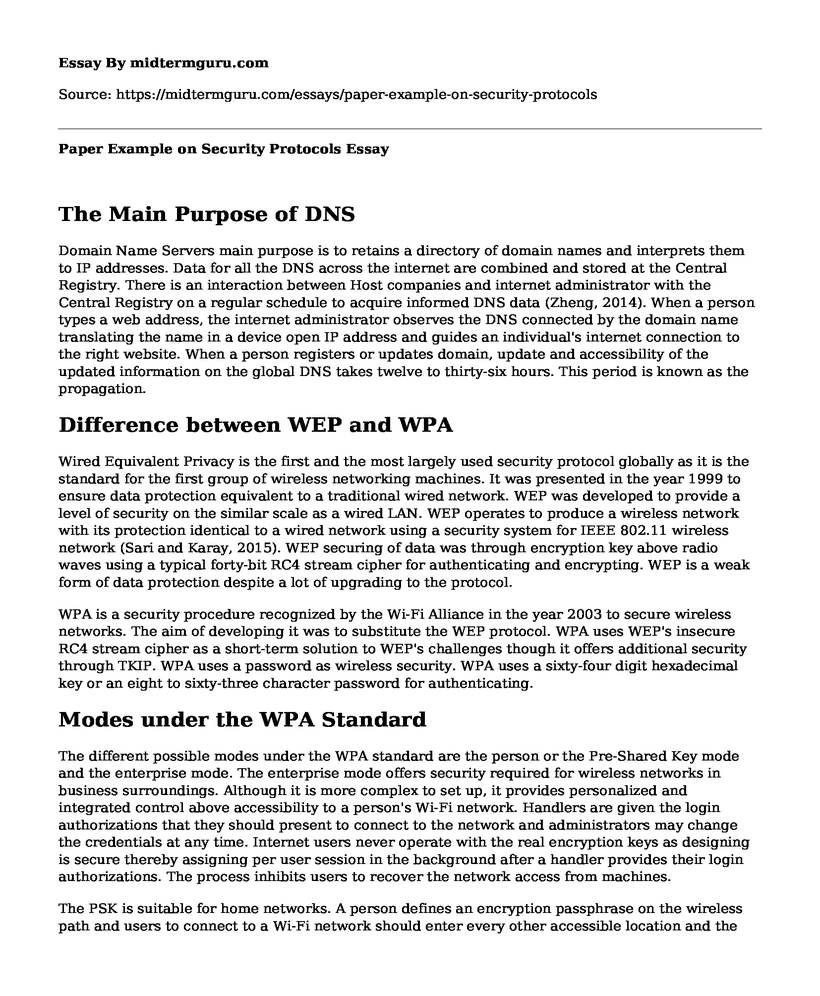The Main Purpose of DNS
Domain Name Servers main purpose is to retains a directory of domain names and interprets them to IP addresses. Data for all the DNS across the internet are combined and stored at the Central Registry. There is an interaction between Host companies and internet administrator with the Central Registry on a regular schedule to acquire informed DNS data (Zheng, 2014). When a person types a web address, the internet administrator observes the DNS connected by the domain name translating the name in a device open IP address and guides an individual's internet connection to the right website. When a person registers or updates domain, update and accessibility of the updated information on the global DNS takes twelve to thirty-six hours. This period is known as the propagation.
Difference between WEP and WPA
Wired Equivalent Privacy is the first and the most largely used security protocol globally as it is the standard for the first group of wireless networking machines. It was presented in the year 1999 to ensure data protection equivalent to a traditional wired network. WEP was developed to provide a level of security on the similar scale as a wired LAN. WEP operates to produce a wireless network with its protection identical to a wired network using a security system for IEEE 802.11 wireless network (Sari and Karay, 2015). WEP securing of data was through encryption key above radio waves using a typical forty-bit RC4 stream cipher for authenticating and encrypting. WEP is a weak form of data protection despite a lot of upgrading to the protocol.
WPA is a security procedure recognized by the Wi-Fi Alliance in the year 2003 to secure wireless networks. The aim of developing it was to substitute the WEP protocol. WPA uses WEP's insecure RC4 stream cipher as a short-term solution to WEP's challenges though it offers additional security through TKIP. WPA uses a password as wireless security. WPA uses a sixty-four digit hexadecimal key or an eight to sixty-three character password for authenticating.
Modes under the WPA Standard
The different possible modes under the WPA standard are the person or the Pre-Shared Key mode and the enterprise mode. The enterprise mode offers security required for wireless networks in business surroundings. Although it is more complex to set up, it provides personalized and integrated control above accessibility to a person's Wi-Fi network. Handlers are given the login authorizations that they should present to connect to the network and administrators may change the credentials at any time. Internet users never operate with the real encryption keys as designing is secure thereby assigning per user session in the background after a handler provides their login authorizations. The process inhibits users to recover the network access from machines.
The PSK is suitable for home networks. A person defines an encryption passphrase on the wireless path and users to connect to a Wi-Fi network should enter every other accessible location and the passphrase. Even if the method seems easier to implement, it is difficult to secure a business network. Unlike the enterprise method, accessing wireless cannot be achieved personally or centrally because; a single passphrase applies to all users (Al-Fandi, 2017). Changing global passphrase must be done physically on all the devices. Different from the enterprise mode, the encryption passphrase is housed in the computers. Consequently, every person on the computer can join the network and get back the encryption passphrase.
How the Three-Way-Handshake Works in TCP
The TCP controls the transfer of information between two machines connected in a network communicating with each other. It contains the application layer, transporting layer, networking layer, data linking layer, and hardware layer. The process is referred to as a three-way handshake as three segments are exchanged connecting the sender and receiver to establish a consistent TCP connectivity.
The first step is the initiation of a connection by computer one with computer two. Hence, computer one directs a segment with Synchronize Sequence Number. The segment informs computer two that computer one wishes to start a communication with computer two and tells computer two the sequence number its section will initiate with. The importance of the sequence numbers is to keep data in order (Hsu et al., 2016).
The second step is that computer two responds to computer one with acknowledgment and SYN bits sets. At this stage, the response of computer two acknowledges the SYN segment of computer one and informs computer one of the sequence number it will initiate its information with. The final step is that computer one acknowledges the starting sequence number and signal of computer two. Finally, computer one transfers the actual information to computer two.
Reference
Zheng, W. (2014). Seamless transition of domain name system (DNS) authoritative servers. Scientific Research and Essays, 9(12), pp.566-570.
Sari, A. and Karay, M. (2015). Comparative Analysis of Wireless Security Protocols: WEP vs WPA. International Journal of Communications, Network and System Sciences, 08(12), pp.483-491.
Al-Fandi, A. (2017). Symmetric Volatile Shared Key Encryption: A Two-way Communication Shared Key Encryption. Mathematics and Computer Science, 2(3), p.27.
Hsu, F., Hwang, Y., Tsai, C., Cai, W., Lee, C. and Chang, K. (2016). TRAP: A Three-Way Handshake Server for TCP Connection Establishment. Applied Sciences, 6(11), p.358.
Cite this page
Paper Example on Security Protocols. (2022, Sep 06). Retrieved from https://midtermguru.com/essays/paper-example-on-security-protocols
If you are the original author of this essay and no longer wish to have it published on the midtermguru.com website, please click below to request its removal:
- Paper Example: Data Management, Standards Development, and Access
- Essay on Globalization and International Security
- Essay on Mitigating the Factors for the Client Service for Netware
- Amazon MIS Case Study Paper Example
- Essay Sample on Roles and Responsibilities of the Project Board
- The Perfect Information Management System: Achieving Timeliness & Efficiency - Research Paper
- A Computer's New Age: Harnessing Electrical Power to Process Data - Essay Sample







